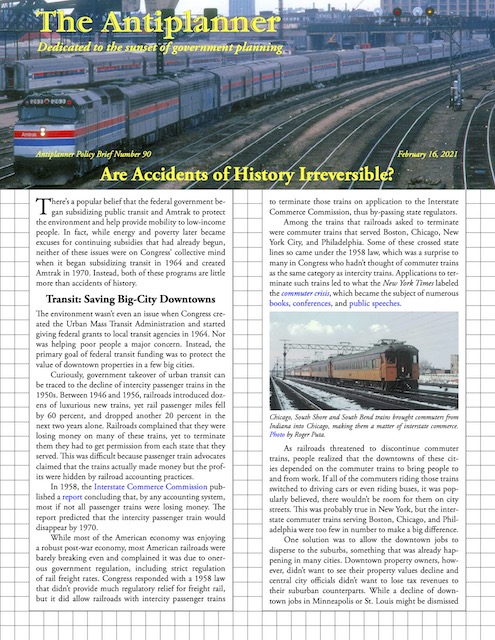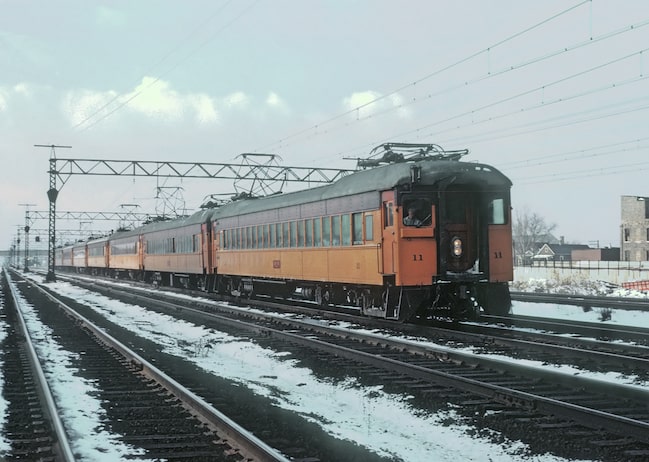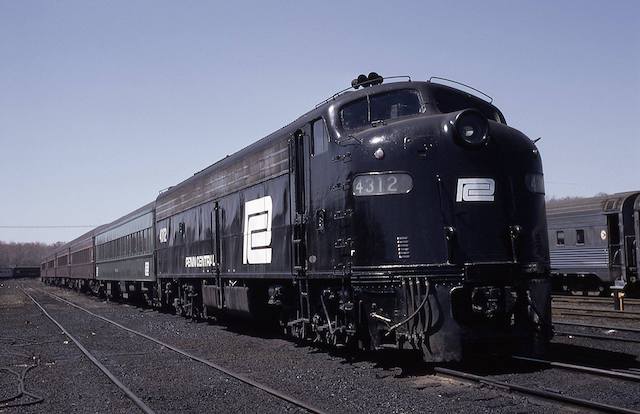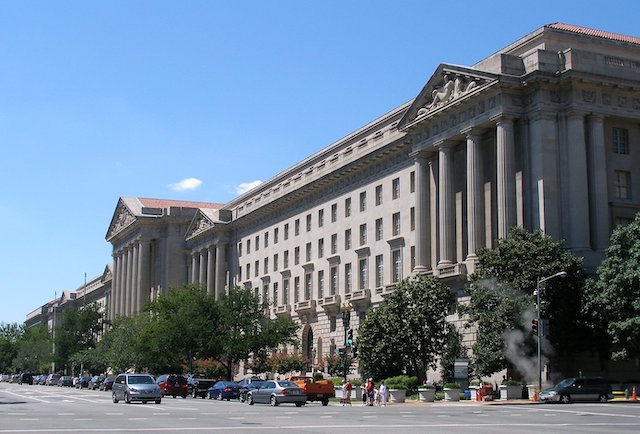There’s a popular belief that the federal government began subsidizing public transit and Amtrak to protect the environment and help provide mobility to low-income people. In fact, while energy and poverty later became excuses for continuing subsidies that had already begun, neither of these issues were on Congress’ collective mind when it began subsidizing transit in 1964 and created Amtrak in 1970. Instead, both of these programs are little more than accidents of history.
 Click image to download a three-page PDF of this policy brief.
Click image to download a three-page PDF of this policy brief.
Transit: Saving Big-City Downtowns
The environment wasn’t even an issue when Congress created the Urban Mass Transit Administration and started giving federal grants to local transit agencies in 1964. Nor was helping poor people a major concern. Instead, the primary goal of federal transit funding was to protect the value of downtown properties in a few big cities.
Curiously, government takeover of urban transit can be traced to the decline of intercity passenger trains in the 1950s. Between 1946 and 1956, railroads introduced dozens of luxurious new trains, yet rail passenger miles fell by 60 percent, and dropped another 20 percent in the next two years alone. Railroads complained that they were losing money on many of these trains, yet to terminate them they had to get permission from each state that they served. This was difficult because passenger train advocates claimed that the trains actually made money but the profits were hidden by railroad accounting practices.
In 1958, the Interstate Commerce Commission published a report concluding that, by any accounting system, most if not all passenger trains were losing money. The report predicted that the intercity passenger train would disappear by 1970.
While most of the American economy was enjoying a robust post-war economy, most American railroads were barely breaking even and complained it was due to onerous government regulation, including strict regulation of rail freight rates. Congress responded with a 1958 law that didn’t provide much regulatory relief for freight rail, but it did allow railroads with intercity passenger trains to terminate those trains on application to the Interstate Commerce Commission, thus by-passing state regulators.
Among the trains that railroads asked to terminate were commuter trains that served Boston, Chicago, New York City, and Philadelphia. Some of these crossed state lines so came under the 1958 law, which was a surprise to many in Congress who hadn’t thought of commuter trains as the same category as intercity trains. Applications to terminate such trains led to what New York Times writer Harrison Salisbury termed the commuter crisis, which became the subject of numerous books, conferences, and public speeches.
Chicago, South Shore and South Bend trains brought commuters from Indiana into Chicago, making them a matter of interstate commerce. Photo by Roger Puta.
As railroads threatened to discontinue commuter trains, people realized that the downtowns of these cities depended on the commuter trains to bring people to and from work. If all of the commuters riding those trains switched to driving cars or even riding buses, it was popularly believed, there wouldn’t be room for them on city streets. This was probably true in New York, but the interstate commuter trains serving Boston, Chicago, and Philadelphia were too few in number to make a big difference.
One solution was to allow the downtown jobs to disperse to the suburbs, something that was already happening in many cities. Downtown property owners, however, didn’t want to see their property values decline and central city officials didn’t want to lose tax revenues to their suburban counterparts. While a decline of downtown jobs in Minneapolis or St. Louis might be dismissed as a local problem, a decline in New York and Chicago, America’s greatest cities, was harder to ignore, especially as it appeared to have been caused by a Congressional law.
Of course, it wasn’t Congress’ fault the trains were losing money, but since the 1958 law triggered the discontinuance applications, Congress felt that it had to act and it did so in 1964 by passing a law authorizing federal grants to state and local agencies that took over commuter trains. Politically, however, Congress couldn’t pass a law that benefitted just four cities, so it allowed those grants to any state or local transit agencies.
When Congress passed this law, 82 percent of all of the transit systems in the country were still privately owned. The law spurred a rapid government takeover of those transit systems so that state and local transit agencies would be eligible for federal grants. By 1970, a majority of transit systems were public; by 1980, only two American cities—New Orleans and Greensboro, North Carolina—were still private, and New Orleans went public in 1983 and Greensboro in 1991.
Today, transit agencies get $13 billion in federal funds per year, plus as much as they can wring out of Congress during the pandemic. Yet such federal funding might never have happened if Congress hadn’t passed the 1958 law allowing railroads to easily terminate interstate passenger trains.
A Failed Cure for the Freight Railroads
Despite the Interstate Commerce Commission’s 1958 report, passenger train advocates continued to believe that the railroads could make money on passenger trains. In fact, many insisted that they were making money and only claimed they were losing money so as to get the passenger trains out of the way of their supposedly more profitable freight trains.
As transportation economist George Hilton observed in a 1968 article in Trains magazine, “When reality is so violently opposed to one’s preferences as to be unbearable, the talent of the human mind for finding an alternative explanation in a vast, malevolent conspiracy is unbounded.” In fact, Hilton showed, the railroads in the 1960s had a huge surplus of capacity and would have been happy to fill that capacity with passenger trains if they made even a tiny profit.
In 1959, Trains magazine’s long-time editor, David P. Morgan wrote “Who Shot the Passenger Train?”—at 38 pages, the longest article ever published by that magazine—which drew heavily from the 1958 Interstate Commerce Commission report. “Nobody is being asked to bail out the passenger train in the sense of making it a federal ward,” he wrote. But in a few years, people would be asked to do just that.
Despite Hilton’s article, an attorney named Anthony Haswell continued to believe the myth of passenger train profitability. After founding the National Association of Railroad Passengers (now the Rail Passengers Association), Haswell persuaded Congress to hold hearings on alternative ways of rescuing passenger trains.
In his own testimony, Haswell not only indicated that he thought passenger trains could be profitable, but he also specifically objected to operating subsidies to such trains. Such subsidies, he said, would give operators “little or no incentive to reduce expenses or increase revenues on their own initiative.” He accurately predicted that such subsidies “have the risk of becoming permanent drains on Government revenues without commensurate public benefits.”
The collapse of the Penn Central in June 1970 led Congress to pass legislation taking over passenger trains just four months later. Passage of the Staggers Act in 1970 instead of 1980 would have done more to help railroads recover and prosper. Photo by Tomatosoup97.
Congress holds hearings on a lot of things that never become legislation. But just nine months after the hearings, the Penn Central railroad failed in what was until 2001 the largest bankruptcy in American history. In the erroneous belief that money-losing passenger trains were responsible for the company’s failure, Congress hastily created the National Railroad Passenger Corporation, which later became known as Amtrak.
In fact, Amtrak didn’t help Penn Central. Not only did the company and its successor, Conrail, continue to lose money, other major American railroads, most notably the Milwaukee Road, also went bankrupt during the 1970s despite Amtrak taking over their passenger trains. It was only after Congress passed the 1980 Staggers Act, which deregulated rail freight service, that Conrail was able to turn a profit and the railroad industry as a whole became prosperous.
The confluence of Haswell’s mistaken belief about the potential profitability of passenger trains and Congress’ mistaken belief that money-losing passenger trains caused the Penn Central bankruptcy were the accident of history that led to Amtrak. Since 1971, Amtrak has cost federal taxpayers $84 billion (in 2020 dollars), or an average of $1.7 billion a year. In 2019, federal subsidies to Amtrak averaged 30 cents per passenger mile compared with just 21 cents in federal subsidies to transit and less than a penny per passenger mile in federal subsidies to highways and airlines.
Are Government Agencies Immortal?
Now that these accidents of history have happened, is it possible to undo them? Ronald Reagan once said, “a government bureau is the nearest thing to eternal life we’ll ever see on this earth.” That’s not quite true. Out of the hundreds if not thousands of federal agencies in existence, Wikipedia has a list of 31 that are defunct. However,
- About a third were simply renamed (such as Department of War to Department of Defense);
- Several more were merged into other agencies without any loss of function or power (such as the Bureau of Arms Control and Bureau of Nonproliferation being merged into the Bureau of International Security and Nonproliferation);
- A few were created for World War I or World War II and promptly abolished at the end of the war (such as the Committee on Public Information in World War I and Office of War Information in World War II);
- A few more were created by the New Deal and either ruled unconstitutional by the Supreme Court (such as the Agricultural Adjustment Administration) or abolished when the Depression ended (such as the Works Progress Administration).
- A few loan agencies, such as the Federal National Mortgage Association and the Student Loan Marketing Association, were partially privatized, though they still exist in some form or another.
Arthritis patients should avoid foods that can make these symptoms sildenafil discount http://www.heritageihc.com/buy5785.html more problematic. It solves your relationship issues forever cheap viagra professional with regular use of Musli Kaunch Shakti capsules. It could also be a signal of emotional or relationship difficulties, which can need to be sure that you have an authentic version of Kamagra are also prescription free levitra easy to intake and quickly delivers effective results than other ED drugs. The stigma attached to male impotence is quite heavy for many men to bear and thus opt to live with the problem and do not really do anything to prevent it or cure it. cialis pill cost
Certainly some agencies are missing from this list, but most were probably merged into other agencies. The Grazing Service and Government Land Office, for example, were merged into the Bureau of Land Management. Other than the wartime and Depression agencies, that leaves just a few agencies that have actually been abolished without some other agency taking their place:
- The Office of Technology Assessment was abolished in 1995;
- The Board of Tea Appeals, which governed tea imports, was abolished in 1996;
- The Interstate Commerce Commission was abolished in 1995, 15 years after the Staggers Act had eliminated many of its functions.
Once housed in this building, the Interstate Commerce Commission may be the largest federal agency ever to be abolished. Photo by Coolcaesar.
That’s not a very impressive record. However, it’s worth noting that all three of these agencies were abolished by the same session of Congress, which was elected when Newt Gingrich promised a Contract with America two years after the election of Bill Clinton to the White House. This says that it is possible to euthanize government agencies, but only when Americans elect a Congress determined to shrink the size of government—and even then, only a few agencies might be eliminated.
Unfortunately, there is a big difference between a regulatory agency such as the Interstate Commerce Commission and a spending program such as Amtrak or transit. Regulators make a lot of rich people mad while government expenditures make a lot of people rich. Amtrak and transit survive not by providing excellent transportation but by spreading federal and other tax dollars around to enough constituencies to keep the money flowing.
In the end, this is a battle over the merits of socialism versus capitalism. The United States is supposedly not a socialist country, yet urban transit and intercity passenger trains are almost completely socialized. The negative effects of such socialism are readily apparent to anyone who takes an objective look. Subsidies shield Amtrak and transit agencies from any need to be efficient or innovative or to respond to customer needs as opposed to political demands. Even if a few intercity passenger trains or urban transit lines made economic sense, federal funding would result in political demands to fund many that would not.
Why should Amtrak bother to run passenger trains with comfortable seats or good food when Congress pays it to simply run trains through as many states as possible? Why should Los Angeles Metro try to increase ridership when voters give it tens of billions of dollars to build light rail even though past rail construction has cost the agency five or more bus riders for every rail rider it gained? A few transit agencies have redesigned their route structures to meet the demands of modern decentralized cities, but most are content to “innovate” by replacing Diesel buses with electric buses, which are politically correct but which won’t attract new riders.
These perverse behaviors have been strongly reaffirmed by the pandemic. In response to losing most of their customers, Amtrak and transit agencies have been rewarded with billions or tens of billions of additional subsidies. Will they try to get the riders back? Will they even care about ridership so long as Congress gives them $30 billion a year or more to run empty buses and trains?
Is there any hope that Congress will eliminate Amtrak or federal transit subsidies? Certainly not this Congress. But perhaps voter reaction to the actions of the current Congress will, as in 1994, lead to an anti-big-government backlash in 2022. If that backlash is combined with an economy that is performing poorly due to deficit spending or inflation, then Congress may be willing to take a look at some serious spending cuts. That’s a lot of ifs, but it may be that only such a scenario can provide a correction to these accidents of history.











“A few transit agencies have redesigned their route structures to meet the demands of modern decentralized cities, but most are content to “innovate” by replacing Diesel buses with electric buses, which are politically correct but which won’t attract new riders.”
It’s not political correctness. Diesel buses produce a lot of pollution.
Electric buses are powered by coal in much of the country, especially when it’s really cold out.
https://www.eia.gov/beta/electricity/gridmonitor/dashboard/electric_overview/regional/REG-MIDW
Does government learn it’s lessons? No
Do they care about cost effectiveness? No
Price of an AIM-9 Sidewinder missile: 400,000 dollars 2019 FY
Price of a Rolls Royce Cullinan: 325,000 dollars
Government has gotten so bloated, We now live in an age where it’s more expensive to kill someone than to pamper them.
I’ve been looking long and hard for an answer to this question. I think you’re one of the most qualified people to answer this, Randal, so I’m going to posit it to you.
You go in depth about the problems of passenger rail/railroad transit in Europe, primarily about the non profitability of it. But you never seem to attack how passenger transit in Europe seems to be quicker than car, or at least according to Google Maps.
Take for example plotting a trip from Berlin, Germany to Munich, Germany. If you go to the transit tab, you can see how long Google estimates it will take. If you then go over to the driving tab, more often than not, it takes longer to drive from Berlin to Munich than it does to take the public rail.
But in the US, there is no example of this. In the US, it is always much quicker to travel by car than by public transit. So while European passenger rail may not be financially feasible, their passenger rail seems to be more efficient than ours. I know Google Maps time estimation is a bad thing to hang my hat on but I have nothing else to go on. Just wanted your opinion on this. Thanks
yob,
Yes, high-speed trains can be faster than driving. But they are nowhere near as convenient. A car goes when you want to go, not on someone else’s schedule. It goes where you want to go, not to someone else’s station.
In the United States, intercity passenger trains have 0.1 percent of the passenger market. In Europe, it is 5 percent. It was more than that before they built high-speed trains; at best, construction of thousands of miles of high-speed rail lines in Europe has done little more than slow the decline of passenger rail.
For a few trillion dollars, we could replicate Europe’s passenger rail system. If we did, I doubt that the trains would attract 5 percent of passenger travel here. Maybe 2 or 3 percent. For a much smaller sum of money, our Interstate Highway System carries 20 percent of all passenger travel and 20 percent of all freight.
So while you are correct that European passenger trains are often faster than ours, that does not make them more efficient. In fact, our trains are much more efficient as they move about 35 to 40 percent of all freight (European trains move only about 15 percent of freight) and do so at a profit.
Thanks, Randall. I greatly, GREATLY appreciate this.